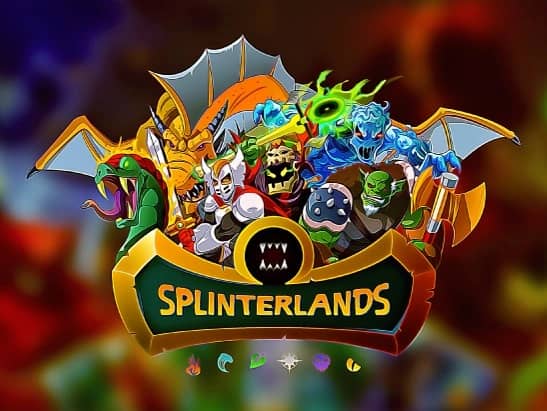Subscribe to wiki
Share wiki
Bookmark
Splinterlands
The Agent Tokenization Platform (ATP):Build autonomous agents with the Agent Development Kit (ADK)
Splinterlands
Splinterlands (Founded in 2018) is a Decentralized, Non-Fungible Token (NFT) card trading and gaming platform built on Blockchain technology. It is similar in concept to games like Magic: The Gathering and Hearthstone where users build up a collection of cards, which all have various different stats and abilities, and use them battle other players in skill-based matches[1].
By using Blockchain technology, players can have their own digital cards, and can trade and sell them freely just as if they were physical cards, without the control of any centralized company, or entity, and all tranactions are recorded publicly and Immutably. On June 1st 2020, Splinterlands switched to the Hive (blockchain) a decentralized, censorship-resistant blockchain[2][3].
Company
The company was founded about four years ago by two independent individuals who go by the names of @aggroed and @yapabmatt on Hive.
Currently located in 827 Parkridge Ave nue Media, Pennsylvania, 19063, United States, it offers Blockchain services and currently employs six full-time distributed staffers and about 15 people total, including part-time and contract workers.
The company Splinterlands has raised a total of $3.6M in funding over 3 rounds. Their latest funding was raised on Jul 27, 2021 from a Initial Coin Offering round.
Splinterlands is funded by 13 investors. Animoca Brands and TechMeetsTrader are the most recent investors[4][5].
It is one of the biggest business success stories in the Cryptocurrency industry and also very successful by the standards of the online gaming industry as a whole[6].
Overview
Co-CEOs Rosen and Jesse Reich launched the game in 2018 under the name Steem Monsters, Splinterlands is a Blockchain-based card game, where the trading cards are non-fungible tokens that allow players to own, trade, and earn their in-game assets. With more than 100,000 registered users (25k of which are paying/premium accounts), the ecosystem ensures higher recognition and interest from the gamer community.
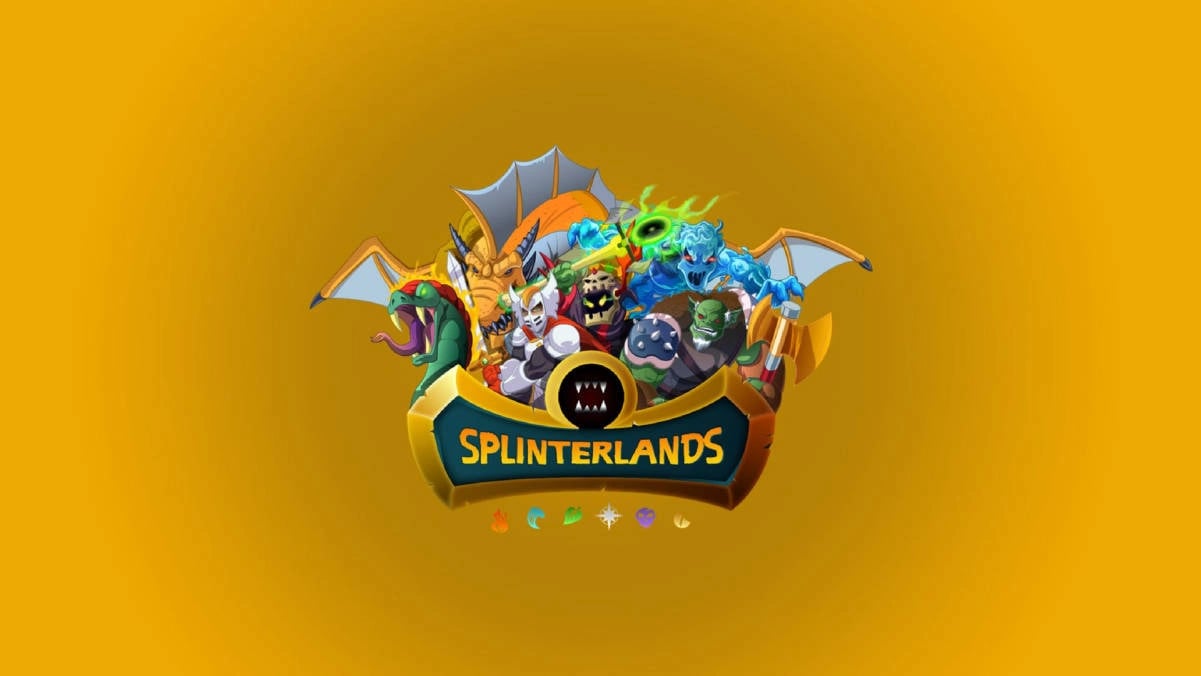
Splinterlands users, to date, have competed in more than 60 million total matches and are creating 600k Blockchain transactions every day, making it one of the most active dApps in the world. The company has awarded millions of dollars in Crypto and NFT to its players in 142 countries.
Splinterlands addresses the problem that most digital card games do not allow players to trade or sell their in-game assets to other players. On top of that, its solutions enhance the future of player-owned economies by launching games on the public Hive Blockchain and offering its in-game assets as NFTs. This also means that users’ cards hold real value, which has the potential to skyrocket according to rarity and market demand[7].
Splinterlands runs on a different blockchain which uses a Dlegated proof of stake consensus system that allows it to handle significantly ,morwe transactions than the Ethereum blokchain, and all with zero transaction fees[1].
In the last weeks, it was the eighth-most popular dapp by number of users, according to DappRadar. Splinterlands says it has 150,000 users in total. When players join Splinterlands, they essentially compete for a limited reward pool of Dark Energy Crystals (DEC) — the in-game cryptocurrency — as well as scarce NFTs. Splinterlands has built a strong following since early 2020, around the time Cointelegraph first analyzed the tit le as part of its crypto games review. Splinterlands’ use of NFTs was considered fairly unique at the time. In the year-and-a-half since, Non-Fungible Token (NFT) have reached mainstream status, with sales topping $2.5 billion between January and June of this year[8].
Advantages of Splinterlands
- It’s relatively cheap to get started with only a $10 entry fee, and you get a free Steem account for that if you don’t already have one.
- Users can put together at least one fairly good deck for around $20–30 that should get you up into the silver leagues relatively soon.
- The front ends are very user-friendly, not too busy, and very easy to navigate and use.
- It’s supported by a broad, supportive community on Discord and the Steem (blockchain) — there’s lots of card giveaway competitions, for example.
- It seems like a great investment — many of the cards have doubled in value over the past few months.
- here’s a seamless integration via Keychain with the Steem (blockchain) which makes cards very easy to trade.
- The Lore and artwork surrounding the splinters and the cards are also great[9][10].
The mechanics of Splinterlands
Splinterlands is a skill-based one on one fighting game. The player matches with an opponent of a similar ranking. These players will be provided with a randomly chosen set of battle parameters. Both players will then have a limited amount of time to create a deck of cards. Once each player has chosen their deck, the battle will start and play automatically according to the predefined game rules. The game can end in either a win or a draw.
Blockchain technology and NFT are the future of gaming, allowing players to trade, sell their assets and properties within the game itself.
In these games, the players own the NFTs. Splinterlands allows you to buy a wide variety of things within the game universe, such as cards, potions, lands, dice, even skins for customization. Each of these items have a role in the gameplay, and can be bought, sold, and even rented to other players. The cards are compatible with third-party market platforms such as Open Sea, PeakMonsters, Monster Market among others.
Players can also earn rewards in tournaments, matches and missions. In this game, there is always a chance to win, regardless of the player’s experience, skill level, or card collection size.
In addition, Splinterlands makes getting involved with Cryptocurrency simple because when registering on the website a Hive wallet is automatically generated for the user to store the coins[11].
The Splintershards (SPS) Token
In May, Splinterlands announced the launch of its own governance token called Splintershards or SPS. Splintershards (SPS) is a new cryptocurrency governance token which will be integrated into the Splinterlands game in order to provide increasing levels of decision-making ability and control over the product to the player-base, asset owners, and other stakeholders.
The Splinterland’s team explains that the token is part of their plans to give their players ownership of the game. Ownership of SPS will make players the members of a Decentralized autonomous organization (DAO)[12][13].
Token Distribution
The SPS token distribution is scheduled to begin this month, and its distribution will last for 5 years and 5 months. The token will exist on the Binance Smart Chain (BSC), and it will give players voting rights over certain governance decisions within Splinterlands. In total there will be 3,000,000,000 SPS tokens, of which 400,000,000 SPS will go to current players and collectors. These 400 million tokens will be sent daily to players over a period of one year. This token will also be used as a reward in the game itself and can be earned through battles, tournaments, guild fights and more.
The primary goal of the token is to reward Splinterlands players and asset holders, which is why 13.33% of the total token supply is going towards an airdrop which will be conducted over a 12 month period to holders of nearly all types of Splinterlands assets. For more information on the airdrop, please see the Airdrop section of this document.
Next, 10% of the total token supply will be added into a foundation which will be controlled exclusively by the DAO. 50,000,000 of the foundation tokens will be issued on day one and the remainder will be released in even increments over the remaining 64 months. This means that SPS token holders will be able to submit proposals and vote on how/if those funds should be used. For more information please see the Foundation / DAO Funds section of this document.
6.66% will be offered directly in a private sale to a select group of advisors and influencers who will help promote both the token and the Splinterlands product to their audiences and networks and generally help ensure that the project is successful. Tokens purchased as part of the private sale will be subject to a vesting period with 10% of the tokens vesting and becoming liquid every month for a total of 10 months. All proceeds from the sale will go towards the development, promotion, and ongoing maintenance of the SPS token and ecosystem.
9% of the total token supply will be reserved for the Splinterlands team. 50,000,000 of these tokens will be issued on day one and the remainder will be released in even increments over the remaining 64 months. Splinterlands will use this pool to help incentivize and retain our valuable team members and partner organizations.
1% of the token supply will be reserved for partners and advisors to the project who will work with the SPS token team and assist and/or provide advice on all areas of the project as well as help to market and promote the project. These tokens will be unlocked in 12 monthly increments starting one year from the launch of the SPS token.
Finally, the remaining 60% of the total token supply will go towards rewarding players, SPS holders, liquidity providers, and oracles. These tokens will be released on a fixed schedule over the 65 month period and go into separate pools for the various different areas to be rewarded. Please see the "Play to Earn & Reward Pools" section of this document for the full distribution schedule and breakdown of these rewards[14].
Airdrop
400M SPS tokens, or 13.33% of the total token supply, will be airdropped to players based upon the amount and type of Splinterlands assets held in their account. Rather than have a specific airdrop date/time with a snapshot as is common, SPS tokens will be airdropped to asset holders on a daily basis over a 1-year period. The goal is to encourage players to accumulate and hold Splinterlands assets over a longer period rather than having a big rush up until the snapshot followed by a dump shortly afterward[15].
Nearly every Splinterlands asset will be eligible to earn SPS tokens in the airdrop. Each type of asset will be assigned a specific amount of "airdrop points" that it is worth. Then the total number of airdrop points will be added up across all assets in all accounts in the game and held externally once each day and ~1,100,000 SPS tokens (400M / 365 days) will be divided by the total number of airdrop points to determine how many SPS tokens each airdrop point is worth that day.
Decentralized Autonomous Organization (DAO)
The Splintershards token will be set up as a Decentralized autonomous organization or DAO via a series of smart contracts which will be published on the Binance Smart Chain (BSC) platform.
The Ethereum Blockchain was the first choice for the governance token contracts; however, the gas fees required to publish transactions to the Ethereum Blockchain have become prohibitively expensive and would greatly limit what can be done with the governance token contracts and the number of people able to participate.
As a result, the Binance Smart Chain (BSC) was chosen due to many factors including its current popularity, low transaction fees, fast transaction confirmation times, and the ability to easily port smart contracts between BSC and Ethereum which will allow the Splintershards contracts to be migrated to Ethereum in the future when/if it makes sense to do so.
Once the smart contracts have been developed and released, users will be able to stake their SPS tokens in the smart contract at which point they can be used for governance voting in the DAO. The Splintershards token will be 100% controlled and governed by the community of token holders, and all aspects of how the token and associated smart contracts function will be able to be changed through a vote of staked SPS holders.
All interactions between the Splinterlands game (which runs on the Hive blockchain) and the SPS tokens (which will run on the BSC blockchain) will be handled via an oracle system[16][17].
Play to Earn & Reward Pools
New SPS tokens will initially be added to the various reward pools at a rate of 37,500,000 tokens per month and will decrease uniformly across all reward pools at a rate of 1% per month, meaning that after one year the monthly contribution rate to the reward pools will drop to 33,239,400 and after 5 years it will have dropped to 20,518,400 SPS per month. These rewards will end after 65 months and at that point no more SPS tokens will be created.
The planned reward pools and the amount of the initial 37,500,000 monthly total rewards allocated to each can be found in the table below. Details about how to earn SPS from each reward pool can be found in the following subsections of this document.
Splinterland main component
Steem Monsters battles take place in the ‘Splinterlands’, and there are 6 splinters: Fire, Water, Life, Earth, Death and Dragon.
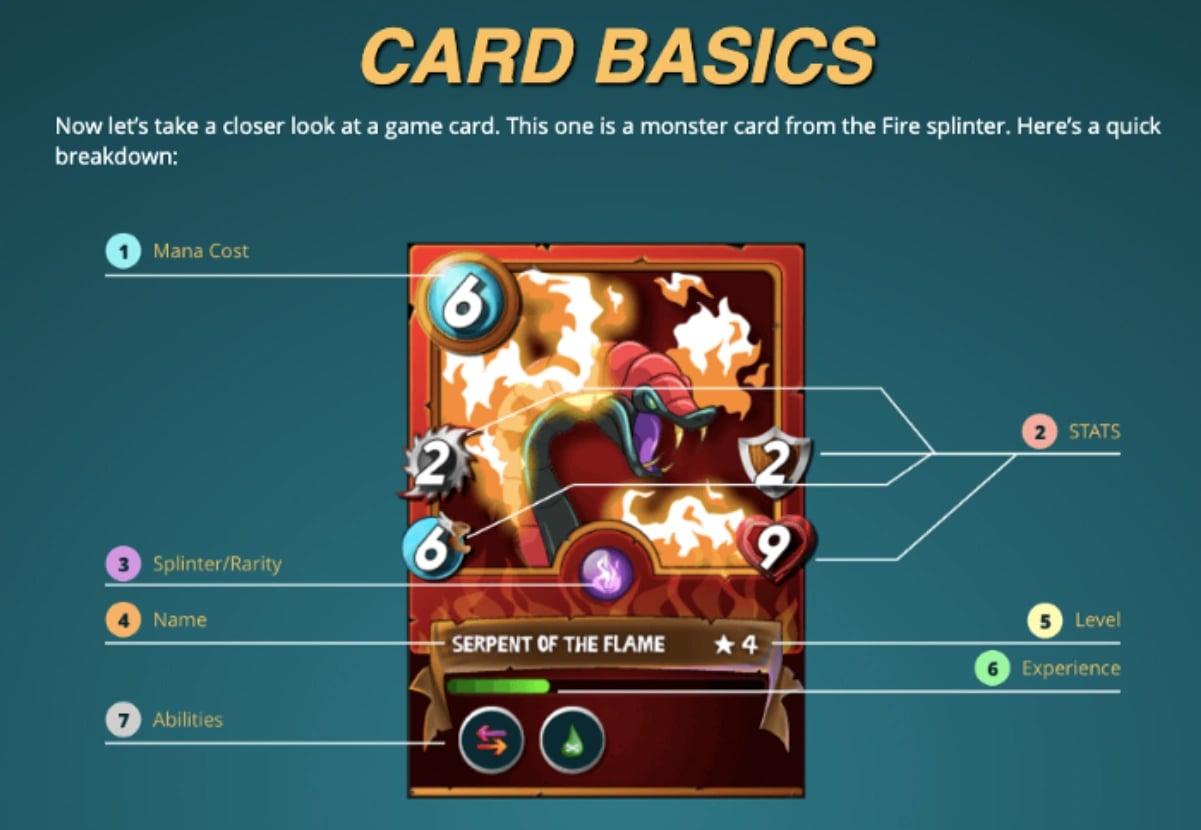
Within each splinter there are two main types of card: summoners and monsters. When it comes to battling, the former ‘summon’ the later who then battle monsters from other teams.
Each monster has various attributes: attack, defence (shield), health, speed, and mana (which limits how many cards you can play), and some monsters have extra abilities. There are five main types of card — tank/ melee/ magic/ ranged/ healing
Both monsters and summoners are graded into common, rare, epic and legendary categories — legendary tending to have more special abilities than ‘weaker’ cards.
Battle overview
When a user clicks ’battle’ the ‘steemmonsters engine’ finds them someone of a broadly similar level and randomly sets the battle parameters — mana levels for battling can vary from 15 to 32, battles have different rules which tend to favour certain splinters and some splinters may be ‘blanked out’ so they can’t use them in that round.
Users get two minutes (less as they progress up the ranks) to select their summoner and monster selection and if they do so within the time (if they don’t lose!) they enter into battle.
This is where it might get disappointing for some: the battles are just automated — so all they can do is sit and watch the outcome (they can alter the speed) or just ‘skip to results’. There is an element of chance — melee and ranged attacks can miss, for example.
Results, points, league tables and rewards
Following a user result, they either gain or lose points relative to the rank of the person they played, and after they gain a certain amount of points that user can climb the rankings into various different leagues — starting off with novice and progressing through bronze, silver, gold, diamond and champion.
Battles are organised into ‘seasons’ which typically last around two weeks and the higher up the league tables you go in any one season, the more reward cards you win at season’s end. In Bronze III (there are three tiers in each colour) they win 5 rewards cards, in Champion they win 150.
Users can also win daily reward cards by playing ‘quests’ — they have to win five battles with a randomly selected splinter. lower down the orders these are limited to one reward card per[18].
Card collection and levelling up cards
The ‘collection’ tab offers a very user friendly interface, enabling users to examine their cards by different types, splinters and levels. If they click on an individual card (such as my Goblin Sorcerer below), they get the option of buying or selling more on the market, revealing the levelling up stats, levelling up by combining cards, sending the card to someone else, or reading about the Lore.
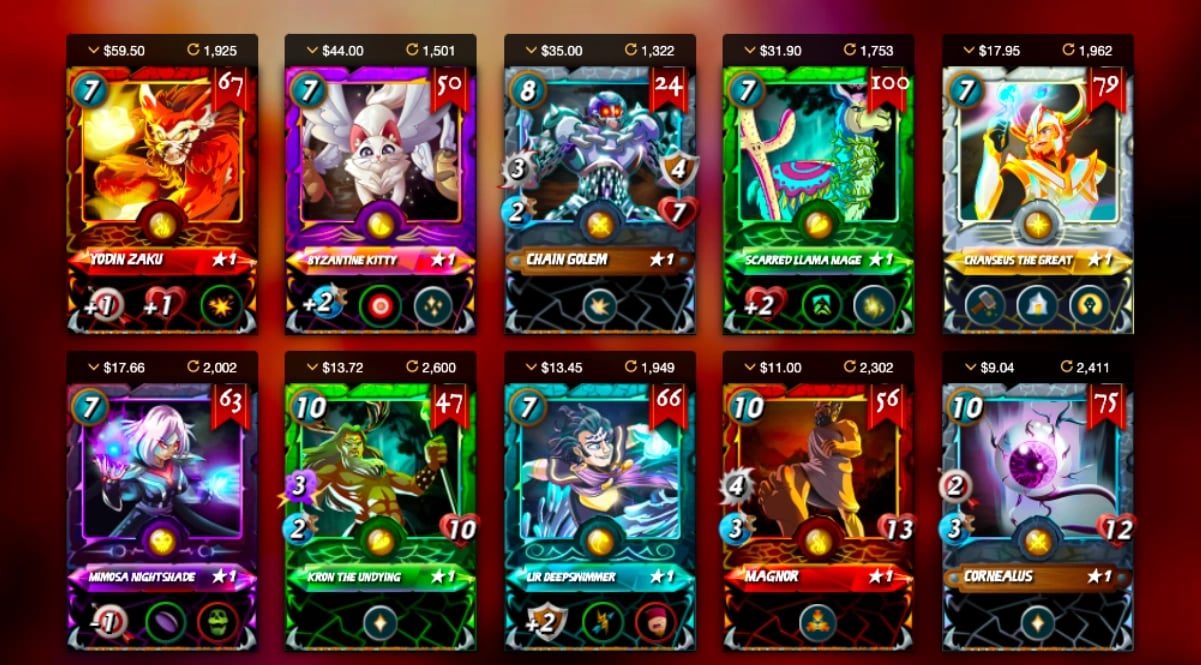
Levelling up cards
In order to level up cards and unlock more abilities they’ll need to combine cards, either cards they’ve won, been sent, or purchased. The further up the levels they go, the more abilities are unlocked. Users can find out about these abilities by looking at the card stats. With the Water Elemental below, for example, they need a total of 21 cards to unlock two abilities and 61 to unlock four damage. After that, a user might decide it’s not worth buying an additional 54 cards to Max it out and add on just +1 health. These diminishing returns at the very top end of levelling up is something they’ll find with a lot of cards.
One will probably have noticed from the above that the further up the levels a user go the more cards they’ll need to progress up to the next level. Different rarities of card require different amounts of cards to ‘max out’. For common cards, it’s 505, rare cards 115, epic 46, and legendary just 11 cards. NB those stats apply to Beta and Rewards cards, Alpha cards require fewer cards to level up, reflected in their higher market price.
Summoners need to be at an appropriate level to allow a user monsters to be played at that level. In other words, a L01 summoner will be able to summon a L10 Goblin Sorcerer, but that Goblin willy only have lower level abilities. Details of summoner in relation to monster abilities can be found on the ‘summoner stats’ under each card[18].
Rarities:
There are four Rarity types: Common, Rare, Epic, and Legendary. Each has different level and circulation caps.
7 Stats:
Compare Mana Cost, forms of Attack (like Melee, Ranged, Magic), Speed, Armor, and Health!
7 Factions:
Otherwise known as "Splinters", the factions are: Fire, Earth, Water, Life, Death, Dragon, and Neutral (mercenaries).
46+ Abilities:
Unique abilities allow players to turn the tide of battle in unexpected and exciting ways
283+ Cards
An ever-growing library of cards give players a robust variety of combinations.
Dark Energy Crystals
Dark Energy Crystals (DEC) are the official in-game currency of Splinterlands. You can earn them in various different ways in the game and they can be used to purchase all sorets of diffrent items and boosts that can help you rise to the top of the leaderboards.
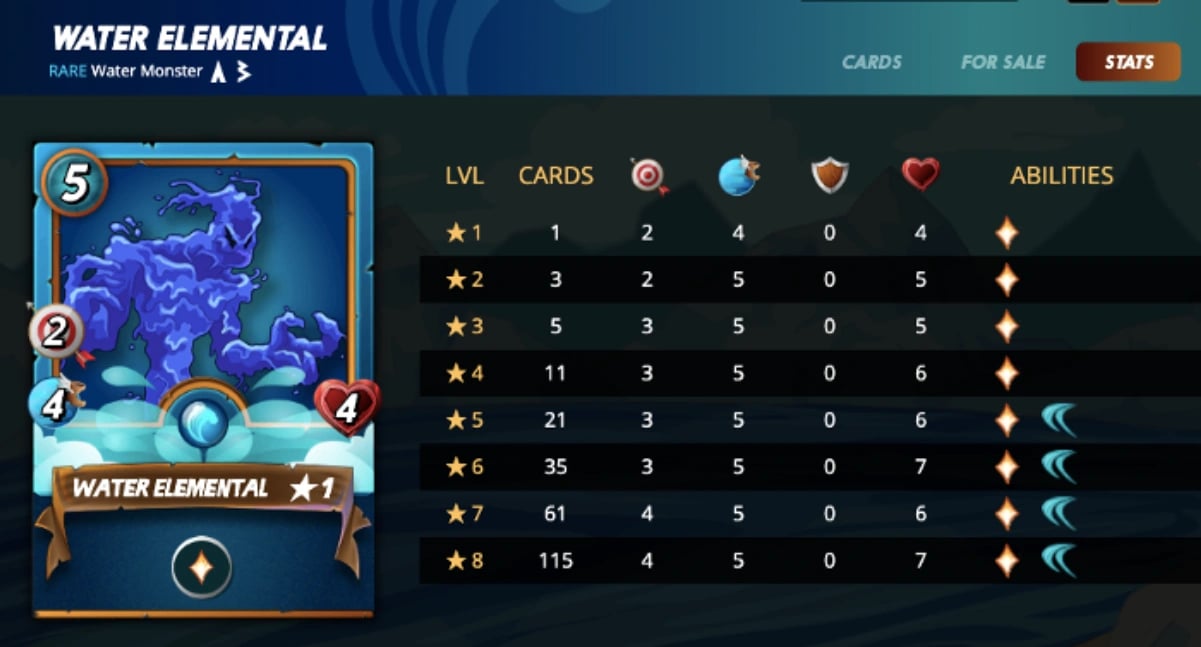
How to acquire Dark Energy Crystals?
There are two ways to obtain Dark Energy Crystals through the game. First, you can convert unused cards in your collection into Dark Energy Crystals by checking the box next to the cards you want to convert and clicking on the Dark Energy Crystal Icon. Higher level cards will convert to more DEC than lower level cards, as will higher rarity cards, and gold foil cards will convert significantly more DEC than the regular versions. There is also a bonus for Alpha and Promo edition cards.
The second way to obtain Dark Energy Crystals is by winning Ranked battles. Each player will earn a portion of the current DEC reward pool for each ranked battle win in proportion to their rating. Players with a high rating will earn more DEC for each win. The amount of DEC earned also depends on the player’s current Energy Capture Rate (ECR). The use of Alpha edition or Gold Foil cards in battle also provides a bonus to the amount of DEC awarded.
Uses of Dark energy crystal
Dark Energy Crystals can be used to purchase a variety of in-game items in the shop. They can be used to purchase Potions which provide various in-game benefits, Essence Orbs which contain 5 random cards from a special, exclusive promo set and skins which are unique and limited. The uses for Dark Energy Crystals will continue to increase over time as new features are added to the game[19].
Tournaments
Tournaments are an increasingly popular part of the Steem Monsters scene, and with > $21K given out so far in prizes, this is not surprising. Most tournaments are for Gold level and above, which means you need maxed out decks to stand any chance of winning, but there are some lower level tournaments, for silver and bronze league players too.
The format for most tournaments is relatively simple — there is a pool of players (some have > 100 taking part), and a number of knock out rounds. You play three matches agains an opponent in round one, and if you win, you progress to round two and so on.
The top-ranked players at the end win prizes!
The Splinterlands marketplace
The market place is, like the ‘collection interface’, extremely user friendly, enabling you to find cards by different types, splinters and levels. In the screenshot below I’ve sorted by ‘Beta’ cards, ‘Earth splinter’ and ‘all levels’.

Alpha cards were the first release of cards, and the only place you can get these is on the market, Betas are what you get if you buy packs and reward cards are what you win for daily quests or at season’s end. All cards are available on the market (assuming they’re for sale), and the different prices reflect what players are wiling to sell them for.
Gold cards are special edition cards. These are a lot more expensive than regular cards, start off at level 04, look nicer, and are some higher level tournaments are for gold cards only.
When it comes to purchasing, to get the best value cards you can sort by price/ BCX if you’re thinking of levelling up. You simply check the box and then click buy. You can check multiple boxes to purchase several cards at once[18][1].
NFT-based game Splinterlands raises $3.6M via private token sale
Splinterlands has just concluded a private token sale that netted the company $3.6 million in proceeds, offering further evidence that investors are keen to back promising Cryptocurrency plays.
The sale centered around the SPS token, which was built for the Splintershards Decentralized Autonomous Organization and will form the basis of game-related governance proposals. Through the SPS token, users will have the ability to influence a range of governance-related decisions, including sponsored tournaments, rewards and card balance updates, among other things.
Several crypto-native funds and ecosystem players contributed to the token raise, including Animoca Brands, Blockchain Founders Fund, Enjin, Polygon, Yield Guild Games, Gate.io, 3Commas Capital, Alpha Sigma Capital, AGE Crypto Asset Investment Fund, TechmeetsTrader, and many others. Individual investors included Ran Neuner as well as the founders of Taiwan Mobile, Simplex and Sandbox.
The token sale concluded around the same time that Splinterlands marked another important milestone: reaching 150,000 players.
Jesse Reich, Splinterlands’ co-founder, and CEO, told Cointelegraph that the game surpassed 100,000 users on June 18, three years and one month since launching. However, the game would then add another 50,000 users over the next six weeks[20][7][21].
“Splinterlands has been pushing limits in crypto gaming for three years. We've played 60 million games and sold out of four editions of cards,” Reich said. “2021 is the best year in company history and business is booming.”The Splinterlands CEO also told Cointelegraph that games like Axie Infinity show how “NFT gaming can be one of the most powerful economic tools on the planet.”
See something wrong?
The Agent Tokenization Platform (ATP):Build autonomous agents with the Agent Development Kit (ADK)
